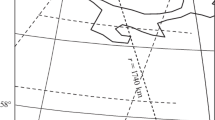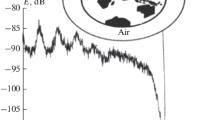Abstract
In September 2019, two out-of-service power transmission lines were used as a horizontal emitting antenna in an experiment conducted on the Kola Peninsula to generate ultra-low-frequency (ULF, 0.38–6.4 Hz) and extremely low–frequency (ELF, 9.4–194 Hz) signals during nighttime hours. The current ranged from 240 A at low frequencies (LF, 0.382 Hz) to 20 A at the highest frequencies (194 Hz). The results of the recording of ULF signals at Staraya Pustyn magnetic station, which is 1610 km away from the transmission line, are presented. The recorded signals had frequencies of 0.6–6.4 Hz and amplitudes normalized to the value of the emitter current ~0.4–0.7 fT/A. Three models were used for theoretical estimates: (1) formulas based on the theory of ELF field excitation over a conducting surface; (2) a numerical model of the ULF field in the atmosphere and ionosphere generated by a linear surface current of infinite length, and (3) a numerical model of a horizontal dipole in the multilayer Earth–atmosphere–ionosphere medium. Model 2 is based on the numerical solution of the system of Maxwell equations in the vertically inhomogeneous atmosphere and ionosphere; its fundamental feature is that it takes into account the contribution of ionospheric waveguide propagation to the excited field at large distances. Model 3 demonstrated the best agreement with the amplitudes of the recorded signals. However, contrary to the predictions of models 1 and 3, the frequency dependence of the amplitude of artificial signals in the 2–8 Hz range is non-monotonic, which may be a manifestation of the effects of waveguide propagation along the ionosphere.







Similar content being viewed by others
REFERENCES
Bannister, P.R., Extremely Low Frequency (ELF) Propagation, Newport: Naval Underwater Systems Center, 1979.
Belyaev, P.P., Polyakov, S.V., Ermakova, E.N., et al., First experiments on generating and receiving artificial ULF (0.3–12 Hz) emissions at a distance of 1500 km, Radiophys. Quantum Electron., 2002, vol. 45, no. 2, pp. 135–146.
Bernstein, S.L., Burrows, M., Evans, J.E., et al., Long range communication at extremely low frequencies, Proc. IEEE, 1974, vol. 62, no. 3, pp. 292–312.
Boteler, D.H. and Pirjola, R.J., The complex image method for calculating the magnetic and electric fields produced at the surface of the Earth by the auroral electrojet, Geophys. J. Int., 1998, vol. 132, pp. 31–40.
Ermakova, E.N., Kotik, D.S., Sobchakov, L.A., Polyakov, S.V., Vasil’ev, A.V., Bosinger, T., and Belova, N.I., Experimental studies of propagation of artificial electromagnetic signals in the range 0.6–4.2 Hz, Radiophys. Quantum Electron., 2005, vol. 48, no. 9, pp. 700–710.
Ermakova, E.N., Kotik, D.S., Polyakov, S.V., et al., A power line as a tunable ULF-wave radiator: Properties of artificial signal at distances of 200 to 1000 km, J. Geophys. Res., 2006, vol. 111, A04305. https://doi.org/10.1029/2005JA011420
Ermakova, E.N., Ryabov, A.V., Pilipenko, V.A., Fedorov, E.N., and Kudin, D.V., New station for monitoring cosmic and atmospheric electromagnetic emissions, Vestn. Otd. Nauk Zemle Ross. Akad. Nauk, 2019, vol. 11, NZ1105. https://doi.org/10.2205/2019NZ000362
Fedorov, E.N., Mazur, N.G., Pilipenko, V.A., and Vakhnina, V.V., Modeling ELF electromagnetic field in the upper ionosphere from power transmission lines, Radio Sci., 2020, vol. 55, e2019RS006943. https://doi.org/10.1029/2019RS006943
Gul’el’mi, A.V., Hydromagnetic diagnostics and geoelectric sounding, Phys.-Usp., 1989, vol. 32, no. 8, pp. 678–696.
Kirillov, V.V., Two-dimensional theory of elf electromagnetic wave propagation in the Earth–ionosphere waveguide channel, Radiophys. Quantum Electron., 1996, vol. 39, no. 9, pp.737–743.
Kirillov, V.V. and Kopeikin, V.N., Formation of a resonance structure of the local inductance of the ionosphere at frequencies 0.1–10 Hz, Radiophys. Quantum Electron., 2003, vol. 46, no. 1, pp. 1–12.
Makarov, G.I., Novikov, B.B., and Rybachek, S.T., Rasprostranenie radiovoln v volnovodnom kanale Zemlya-ionosfera i v ionosfere (Radiowave Propagation in the Earth–Ionosphere Waveguide Channel), Moscow: Nauka, 1993.
Mazur, N.G., Fedorov, E.N., Pilipenko, V.A., and Vakhnina, V.V., ULF electromagnetic field in the upper ionosphere excited by lightning, J. Geophys. Res., 2018, vol. 123, pp. 6692–6702. https://doi.org/10.1029/2018JA025622
Pilipenko, V.A., Chugunova, O.M., Engebretson, M.J., and Lessard, M., Trans-polar propagation of Pi1 wave burst as observed by an Antarctic array during the Themis 2007/03/23 substorm, in Physics of Auroral Phenomena: Proc. 34th Annual Seminar, Apatity, 2011, pp. 86–89.
Pilipenko, V. and Fedorov, E., Coupling mechanism between geoacoustic emission and electromagnetic anomalies prior to earthquakes, Res. Geophys., 2014, vol. 4, id 5008. https://doi.org/10.4081/rg.2014.5008
Pilipenko, V.A., Parrot, M., Fedorov, E.N., and Mazur, N.G., Electromagnetic field in the upper ionosphere from ELF ground-based transmitter, J. Geophys. Res., 2019, vol. 124. https://doi.org/10.1029/2019JA026929
Potapov, A.S., Polyushkina, T.N., Tsegmed, B., et al., Considering the potential of IAR emissions for ionospheric sounding, J. Atmos. Sol.-Terr. Phys., 2017, vol. 164, pp. 229–234. https://doi.org/10.1016/j.jastp.2017.08.026
Sobchakov, L.A., Astakhova, N.L., and Polyakov, S.V., Excitation of electromagnetic waves in a plane waveguide with anisotropic upper wall, Radiophys. Quantum Electron., 2003, vol. 46, no. 12, pp. 918–927.
Tereshchenko, E.D., Grigor’ev, V.F., Sidorenko, A.E., et al., Effect of the ionosphere on electromagnetic waves from ground-based emitter in the frequency band 1–10 Hz, Geomagn. Aeron. (Engl. Transl.), 2007, vol. 47, no. 6, pp. 810–811.
Tereshchenko, E.D., Ivanov, N.V., Sidorenko, A.E., and Grigor’ev, V.F., Investigation of the peculiarities of artificial electromagnetic signal propagation at high latitudes in the range 0.1–10 Hz, Geomagn. Aeron. (Engl. Transl.), vol. 50, no. 5, pp. 632–642.
Tereshchenko, E.D., Tereshchenko, P.E., Sidorenko, A.E., Grigor’ev, V.F., and Zhamaletdinov, A.A., Effect of ionosphere on the excitation of electromagnetic field at extremely low and lower frequencies in the near-field zone, Tech. Phys., 2018, vol. 63, no. 6, pp. 881–887. https://doi.org/10.1134/S1063784218060233
Vaisleib, Yu.V. and Sobchakov, L.A., A dipole near the flat interface of two media, in Antenny: Sb. nauch. statei. (Antennas: Collection of Scientific Articles), Pistol’kors, A.A., et al. (Eds.), Moscow: Svyaz’, 1979, vol. 27, pp. 98–109.
Velikhov, E.P., Zhamaletdinov, A.A, Sobchakov, L.A., et al., The test of the frequency electromagnetic sounding of the Earth crust by means of powerful ULF antenna, Dokl. Akad. Nauk, 1994, vol. 338, no. 1, pp. 106–109.
Zhamaletdinov, A.A., Shevtsov, A.N., Velikhov, E.P., et al., Study of interaction of ELF–ULF range (0.1–200 Hz) electromagnetic waves with the earth’s crust and the ionosphere in the field of industrial power transmission lines (FENICS experiment), Geofiz. Protsessy Biosfera, 2015, vol. 14, no. 2, pp. 5–49.
Zhamaletdinov, A.A., Velikhov, E.P., Shevtsov, A.N., Skorokhodov, A.A., Kolobov, V.V., Ivonin, V.V., and Kolesnikov, V.V., The Murman-2018 Experiment on remote sensing in order to study the “impenetrability” boundary at the transition between brittle and plastic states of the crystalline Earth’s crust, Dokl. Earth Sci., 2019, vol. 486, no. 3, pp. 575–579.
ACKNOWLEDGMENTS
We express our gratitude to the reviewer for constructive comments.
Funding
This study was funded by the Russian Foundation for Basic Research, project nos. 18-05-00108 and 18-05-00528 (ZhAA, ShAN).
Author information
Authors and Affiliations
Corresponding authors
Additional information
Translated by M. Chubarova
Rights and permissions
About this article
Cite this article
Ryabov, A.V., Pilipenko, V.A., Ermakova, E.N. et al. Detection of Artificial ULF Signals at Staraya Pustyn Magnetic Station during the FENICS-2019 Experiment. Geomagn. Aeron. 61, 365–375 (2021). https://doi.org/10.1134/S0016793221030130
Received:
Revised:
Accepted:
Published:
Issue Date:
DOI: https://doi.org/10.1134/S0016793221030130




